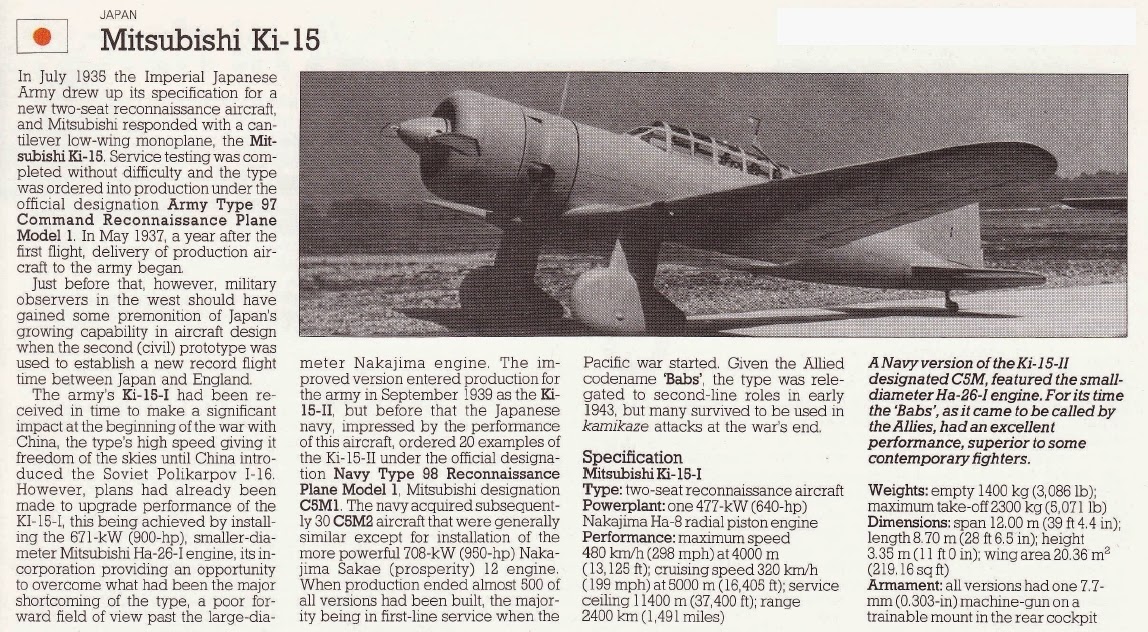Tuesday, March 3, 2015
Mitsubishi Ki-15
The Ki-15-I was almost immediately placed into operational service at the beginning of the war with China in 1937. The aircraft proved useful in the early period of the Second Sino-Japanese War and performed missions deep into Chinese strategic rear areas, as far as reaching Lanzhou. Its high speed gave it a distinct advantage until the Chinese Air Force acquired Soviet Polikarpov I-16 fighters. This aircraft was used for level bombing, close support and photo reconnaissance before being eventually replaced by the Mitsubishi Ki-30.
Plans were already in hand to improve the Ki-15-I, and in September 1939 the Ki-15-II was put into production with the 671 kW (900 hp) Mitsubishi Ha-26-1; the smaller diameter of this both reduced drag and overcame one of the major shortcomings of the initial version: poor forward field of view past the large-diameter of the initial Nakajima Kotobuki engine. The improved version entered production in September 1939 as the Ki-15-II.
The Japanese Navy, impressed by the performance of this aircraft, ordered 20 examples of the Ki-15-II under the designation “Navy Type 98 Reconnaissance Plane Model 1," or Mitsubishi designation C5M1, even before the Army. The Navy acquired subsequently 30 C5M2 aircraft which had an even more powerful 708 kW (949 hp) Nakajima Sakae 12 engine. They were used for reconnaissance duties. In a subsequent upgrade, the army also experimented with an even more powerful engine with 783 kW (1,050 hp) Mitsubishi 102 radial in the Ki-15-III which did not enter production.
When production ended, approximately 500 examples of all versions of the Ki-15 had been built, the majority in front-line service when the Pacific War began. By 1943, the Ki-15 had been relegated to second-line roles, but numbers were expended in kamikaze attacks in the closing stages of World War II.
Variants
Karigane I : Prototype version for civilian use
Ki-15-I (Army Type 97 Command Reconnaissance Plane Model 1) : Initial production variant for the Japanese Army, with Nakajima Ha-8 (Army Type 94) 640 hp at take-off, 900 hp at 11,810 ft (3,600 m)
Ki-15-II (Army Type 97 Command Reconnaissance Plane Model 2) : Improved Army production version with smaller, more powerful engine 14-cilinder Mitsubishi Ha-25-I (Army Type 99 Model 1) , with 850 hp at take-off, 900 hp at 11,810 ft. This gave an increased maximum speed of 317 mph at 14,205 ft (510 km/h at 4,300 m), roughly comparable with fighters like Hawker Hurricane or the Nakajima Ki-43 Hayabusa. The climb was even more improved: 16,405 ft (5,000 m) in 6 min 49 sec (6,83 min). This was archived despite the increase in weight (empty, normal, max: 3,510 vs 3,084 lb, normal 4,826 vs 4,482 and max 5,470 vs 5,071 lb). Maiden flight in June 1938, production started in September 1939[5]
Ki-15-III : Proposed upgraded version, did not enter production version. It had the Mitsubishi Ha-102 engine (1,080 hp at take-off, 1,055 hp at 9,185 ft and 950 hp at 19,030 ft), with a top speed of 329 mph (530 km/h), rougly the same of Ki-46 Dinah. But this latter was expected to be far better in other ways (endurance, two engine, etc), so this version never went in production, even if it was proposed since 1939
C5M1 (Navy Type 98 Reconnaissance Plane Model I) : Improved version of Ki-15-I for the Japanese Navy
C5M2 (Navy Type 98 Reconnaissance Plane Model 2) : Upgraded version of C5M1 with more powerful engine for the Japanese Navy
Subscribe to:
Post Comments (Atom)

No comments:
Post a Comment